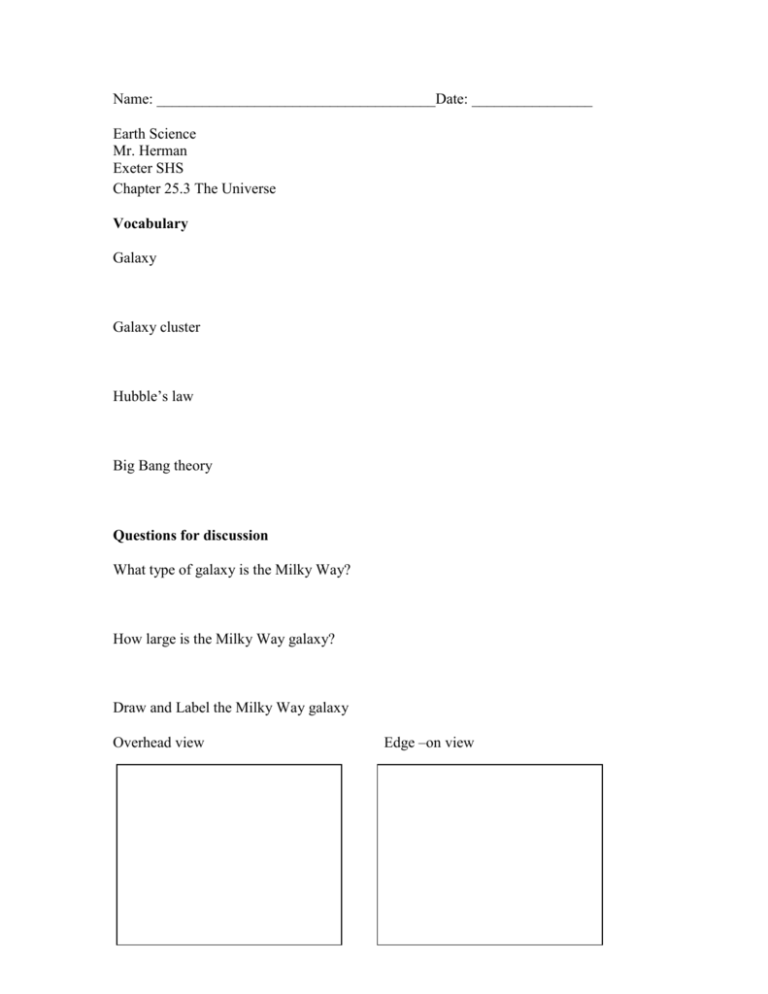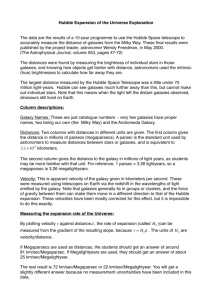Earth Science: The Universe - Galaxies & Big Bang Theory
advertisement

Name: _____________________________________Date: ________________ Earth Science Mr. Herman Exeter SHS Chapter 25.3 The Universe Vocabulary Galaxy Galaxy cluster Hubble’s law Big Bang theory Questions for discussion What type of galaxy is the Milky Way? How large is the Milky Way galaxy? Draw and Label the Milky Way galaxy Overhead view Edge –on view Where is the Earth located in the Milky Way galaxy? Name the three types of galaxies 1. 2. 3. Besides shape, what are the three major differences between the three types of galaxies? What is red shift? What did the red shift tell us about galaxy’s? How did the universe begin according to the big bang theory? How long ago was the universe created according to the big bang theory? Why is the big bang theory so hotly debated by scientists? Objective Describe the size and structure of the Milky Way galaxy? List the ways in which galaxies differ from one another Cite the evidence that indicates the universe is expanding Describe how the universe began according to the big bang theory The Milky Way Galaxy A galaxy is a group of stars, dust, and gases held together by gravity. Size of the Milky Way The Milky Way is a large spiral galaxy whose disk is about 100,000 light-years wide and about 10,000 light-years thick at the nucleus. Structure of the Milky Way Radio telescopes reveal that the Milky Way has at least three distinct spiral arms, with some splintering. Structure of the Galaxy Types of Galaxies Spiral Galaxies About 30 percent of all galaxies are spiral galaxies. They have large diameters of 20,000 to 125,000 light-years and contain both young and old stars. Elliptical Galaxies About 60 percent of galaxies are classified as elliptical galaxies. Elliptical galaxies range in shape from round to oval. Irregular Galaxies Only 10 percent of the known galaxies have irregular shapes and are classified as irregular galaxies. In addition to shape and size, one of the major differences among different types of galaxies is the age of their stars. Irregular galaxies contain young stars. Galaxy Clusters A galaxy cluster is a system of galaxies containing several to thousands of member galaxies. The Expanding Universe Red Shifts Red shift, or a Doppler shift toward the red end of the spectrum, occurs because the light waves are “stretched,” which shows that Earth and the source are moving away from each other. Hubble’s Law Hubble’s law is a law that states that the galaxies are retreating from the Milky Way at a speed that is proportional to their distance. The red shifts of distant galaxies indicate that the universe is expanding. Hubble’s Law To help visualize the nature of the universe, imagine a loaf of raisin bread dough that has been set out to rise for a few hours. As the dough doubles in size, so does the distance between all the raisins. Those objects located father apart move away from each other more rapidly. The big bang theory states that at one time, the entire universe was confined to a dense, hot, supermassive ball. Then, about 13.7 billion years ago, a violent explosion occurred, hurling this material in all directions.









